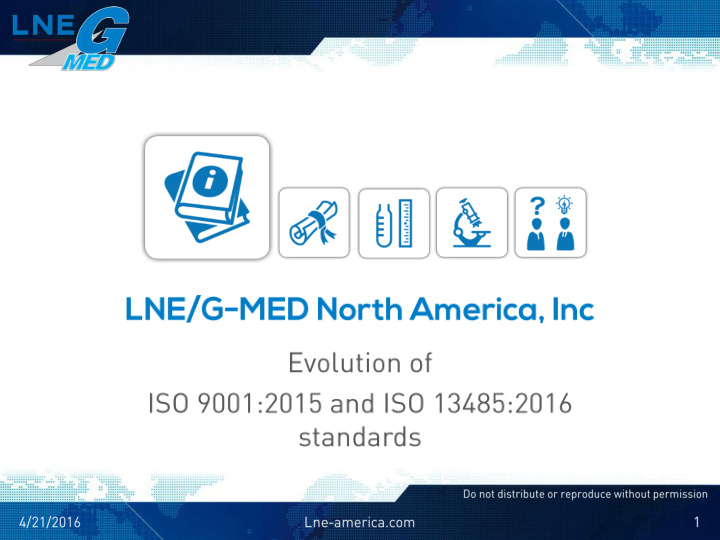



• • • • • •
• • • • • •
Integration with other management system standards
4. Context of the organization 4.1 Understanding of the organization and its context 4.2 Understanding the organization and its context 4.3 Determining the scope of the quality management system 4.4 QMS and its processes 5. Leadership 5.1 Leadership and commitment 10. Improvement 5.2 Policy 5.3 Organizational roles, responsibilities and authorities 10.1 General 10.2 Nonconformity and corrective action 10.3 Continual improvement 6. Planning 6.1 Actions to address risks and opportunities 6.2 Quality objectives and planning to achieve them 6.3 Planning of changes 7. Support 7.1 Resources 7.2 Competence 7.3 Awareness 7.4 Communication 7.5 Documented information 9. Performance evaluation 8 Operation 9.1 Monitoring, measurement, analysis and evaluation 8.1 Operational planning and control 9.2 Internal audit 8.2 Requirements for products and services 9.3 Management review 8.3 Design and development of products and services 8.4 Control of externally provided processes, products and services 8.5 Production and service provision 8.6 Release of products and services 8.7 Control of nonconforming outputs In bold: HLS Structure common sections
• • • • • •
Merged in Process Approach
4. Context of the organization Inclusion of the context of the organisation and interested parties 4.1 Understanding the organization and its context 4.2 Understanding the needs and expectations of interested Reinforcement of the requirements related to the processes parties 4.3 Determining the scope of the quality management system 4.4 Quality management system and its processes 5. Leadership Management responsibility accentuated 5.1 Leadership and commitment 5.2 Policy Suppression of the requirement related to the 5.3 Organizational roles, responsibilities and authorities management representative 6. Planning Preventive actions replaced and extented to actions 6.1 Actions to address risks and opportunities taken to address risks and opportunities 6.2 Quality objectives and planning to achieve them 6.3 Planning of changes Reinforcement of the requirements on planning of changes 7. Support Integration of organizational knowledge 7.1 Resources Reinforcement of requirements related to awareness and 7.2 Competence communication 7.3 Awareness Reduction of the documentation (absence of requirement related to 7.4 Communication 7.5 Documented information quality manual and mandatory procedures) 8. Operations Reinforcement of the requirements related to the 8.1 Operational planning and control 8.2 Requirements for products and services control of operational activities (external providers, 8.3 Design and development of products and services post delivery activities , modifications…) 8.4 Control of externally provided processes, products and services 8.5 Production and service provision 8.6 Release of products and services 8.7 Control of non conforming outputs
10. Improvement Removal of the words « preventive actions ». Those actions 10.1 General 10.2 Non conformity and corrective action are considered in the actions to face risks identified in 10.3 Continual improvement chapter 6. Reinforcement of the requirements related to monitoring, 9. Performance evaluation 9.1 Monitoring, measurement, analysis and measurement, analysis and evaluation evaluation 9.2 Internal audit 9.3 Management review
• • • • • •
Publication of 15 months before 4 months before the standards the end of the the end of the Version 2015 transition period transition period 2018 2015 2018 May Sept Sept End of the transition Beginning of the transition period period From May 2018 : all audits will be From June 2017 : exclusively Beginning of the - Initial certification audits will be conducted conduction of exclusively conducted according to audits of according to version 2015, version 2015 (end transition* in Expiration of the of transition audits) version 2015 - Renewal audits will be certificates mandatorily transition audits. ISO 9001:2008 * Transition audit : audit conducted against the requirements of the version 2015 which can be : - With a joint audit of surveillance or renewal ISO9001:2008 Independent . -
• • • • • •
• The Standard expects that the Organization: identifies its role(s) under applicable regulatory requirements; identifies the regulatory requirements that apply to its activities under these roles; incorporates these applicable regulatory requirements within its quality management system. • (4.1.1) Roles undertaken by the Organization can include: manufacturer, authorized representative, Importer distributor
• •
Key points
The Organization shall
The Organization shall
Key points
• •
• • • • • •
ISO Transition Planning Guidance for ISO 13485:2016 (position paper ISO/TC 21 0/WG 1 N 233) – Nov 2015: 4.2 Co-existence period
2016 version was published 12 months prior to the end of the transition period 2019 2016 03 r /01 02/28 End of the Transition period starts transition period From this date: Beginning of - Initiale certification transition audits will only be audits* against performed according to 2016 version End of validity of the 2016 revision, certificates - Renewal audit will be ISO 13485:2003 transition audits NF EN ISO 13485:2012 * Transition audit: audit against the requirements of the 2016 revision that can be: - Joint audit with surveillance or renewal audit ISO 13485:2003 - Independant.
• • • • • •
Define transition Perform action plan gap including analysis Review, provisions for training certification Aquire the standard
Recommend
More recommend